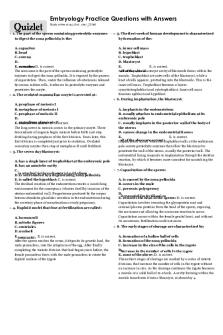Practice questions PDF

| Title | Practice questions |
|---|---|
| Author | Rhea ZHENG |
| Course | Economic strategy and negotiation |
| Institution | University of Sydney |
| Pages | 4 |
| File Size | 110.6 KB |
| File Type | |
| Total Downloads | 49 |
| Total Views | 196 |
Summary
practice questions...
Description
Practicequestions2 1.InaNashequilibrium: a.Allplayersadopttheirbeststrategies,giventhestrategiesadoptedbyallotherplayers. b.Thestrategychosenbyeachplayermustbeadominantstrategy. c.Surplusisnevermaximised,eventhougheachplayeradoptstheirbeststrategygiventhe strategiesadoptedbyallotherplayers. d.Alloftheabove. e.aandbarecorrect. 2.ConsiderthefollowinggameinvolvingSonyandNintendo.Eachhastodecideonanewplatform foritsnewgenerationofgames.Inthenormal‐formgamebelow,thefirstpayoffisforSonyandthe secondisforNintendo.WhatisSony’spreferredoutcome?WhatisNintendo’spreferredoutcome? WhataretheNashequilibriumorequilibriaofthegame?Explainyouranswer.
Nintendo
Platform 1
Platform 2
Platform 1
(20, 20)
(5, 7)
Platform 2
(8, 2)
(30, 30)
Sony
3.HPandEPSONarebothconsideringsimultaneouslywhethertouseaNEWtechnologyintheir nextprinter,orwhethertocontinueusingtheOLDtechnology.IftheybothoptforNEW,thepayoffs are2toeachfirm.IfbothfirmsinsteadoptfortheOLDtechnology,thepayoffsare1toeachfirm.If HPchoosesNEWandEPSONoptsforOLD,thepayoffsare20toHPand4forEPSON.Finally,ifHP optsforOLDandEPSONchoosesNEWthepayoffsare7toHPand5toEPSON.WhatistheNash equilibrium(orequilibria)ofthegame?(ThefirststrategyisHP’s,thesecondisthestrategyof EPSON.)
a.(OLD,NEW) b.(NEW,OLD) c.(OLD,NEW)and(NEW,OLD) d.(NEW,NEW)and(OLD,OLD) e.NoneoftheaboveareNashequilibriaofthegame. 4.Twofirmsplaythefollowinggameconcerningtheadoptionofanewtechnology,ornot. Firm2
Old
Old
New
0,0
0,0
0,0
50,50
Firm1 New
WhataretheNashequilibria?Relateyouanswertofirmsbeingtrappedina‘bad’outcome. 5.Explainwhyalldominant‐strategyequilibriaarealsoNashequilibria,butnotallNashequilibria aredominant‐strategyequilibria.Illustrateyouranswerusingexamples. 6.AppleandSamsungareconsideringlaunchinganewversionoftheirrespectivehandsets.The choicesforeachfirmaretoEnterortoWait.Thetwofirmsmakethesechoicessimultaneously.The payoffsareasfollows.IfbothfirmschoosetoEnter,thepayoffis9toeachfirm.Ifbothfirmschoose toWait,thepayoffsare7toAppleand5toSamsung.IfAppledecidestoWaitandSamsungEnters, thepayoffsare8toAppleand4toSamsung.Finally,ifAppleEntersandSamsungWaits,thepayoffs are6and7toAppleandSamsung,respectively.WhataretheNashequilibriaofthegame? a.(Enter,Enter),wherethefirststrategyisthestrategyofSamsungandsecondisApple’s. b.(Enter,Wait)and(Wait,Enter) c.(Enter,Enter)and(Wait,Wait)
d.(Wait,Wait) e.(Enter,Wait) 7.OnapeacefulSundayafternoon,MalcolmandAnguseachsimultaneouslydecidewhethertogo toGreystanes(G)orRootyHill(RH).IfbothchoosetogotoGreystanestheyget5each.Ifbothgoto RootyHilltheyeachgetapayoffof1.IfMalcolmchoosesGreystanesandAngusRootyHillthe payoffsare(3,2)toMalcolmandAngus,respectively.IfMalcolmgoestoRootyHillandAngus Greystanes,thepayoffsare0toeachparty.Whatis/aretheNashequilibriainthisgame?Isthisalso adominantstrategyequilibrium? 8.ConsiderthefollowinggameinwhichSallycanplayTorBandJohnchoosesbetweenLorR.Each playermakestheirchoicesimultaneously.IfSallychoosesTandJohnchoosesL,Sallygetsapayoffof 5andJohnhasapayoffof4.IfSallyplaysTandJohnR,Sally’spayoffis8andJohngets3.IfSally ChoosesBandJohnL,thepayoffsare3toSallyand2toJohn.Finally,ifSallychoosesBandJohnR, thepayoffsare7toSallyand0toJohn.Whichstatementistrue? a.TheNashequilibriumis(B,R);thisisaprisoners’dilemma b.TheNashequilibriumis(T,R);thisisaprisoners’dilemma c.TheNashequilibriumis(T,R);thisisnotdominantstrategyequilibrium d.TheNashequilibriumis(T,L);thisisadominantstrategyequilibrium e.Noneoftheabove 9.CoopersandBoagsaretwobrewersthatchoosetolaunchasummerale(SA)ornot(NOT).The payoffsareasfollows:ifbothbrewersoptforSABoagsgets8andCoopersgetsapayoffof5;ifboth firmsoptforNOT,Boagsgets4andCoopersgets7;ifBoagschoosesSAandCoopersNOT,the payoffsare5toBoagsand3toCoopers;andifBoagsoptsforNOTandCoopersforSAthepayoffs are6toeachfirm,respectively.Drawthenormalformofthegame.WhatistheNashequilibrium? 10.DellandHPmustbothsimultaneouslypricesfortheirnewlaptops.Theycanbotheitherchoose tosetaLoworHighprice.Thepayoffsareasfollows.IfbothfirmssetaLowprice,Dellgets5andHP 6.IfbothfirmssetaHighprice,thepayoffsare7toDelland8toHP.IfDellsetsaHighpriceandHP choosesLow,thepayoffsare3toDelland10toHP.IfDellsetsaLowpriceandHPoptsforHigh,the payoffsare9toDelland1toH.WhatistheNashequilibrium? a.(Low,High),wherethefirststrategyisDell’sandthesecondHP’s. b.(High,Low),wherethefirststrategyisDell’sandthesecondHP’s. c.(High,High),wherethefirststrategyisDell’sandthesecondHP’s.
d.(Low,Low),wherethefirststrategyisDell’sandthesecondHP’s e.Noneoftheabove...
Similar Free PDFs

Practice Questions
- 7 Pages

Practice+questions
- 1 Pages

Practice Questions
- 9 Pages

Practice Questions
- 14 Pages

Practice questions
- 235 Pages

Practice Questions
- 2 Pages

Practice questions
- 4 Pages

Practice Questions
- 2 Pages

practice questions
- 6 Pages

Wk 2 - Practice Questions
- 1 Pages

Embryology Practice Questions
- 16 Pages

Exam 2 practice questions
- 14 Pages

Ch5 - Practice Questions
- 8 Pages

Community Final Practice Questions
- 60 Pages
Popular Institutions
- Tinajero National High School - Annex
- Politeknik Caltex Riau
- Yokohama City University
- SGT University
- University of Al-Qadisiyah
- Divine Word College of Vigan
- Techniek College Rotterdam
- Universidade de Santiago
- Universiti Teknologi MARA Cawangan Johor Kampus Pasir Gudang
- Poltekkes Kemenkes Yogyakarta
- Baguio City National High School
- Colegio san marcos
- preparatoria uno
- Centro de Bachillerato Tecnológico Industrial y de Servicios No. 107
- Dalian Maritime University
- Quang Trung Secondary School
- Colegio Tecnológico en Informática
- Corporación Regional de Educación Superior
- Grupo CEDVA
- Dar Al Uloom University
- Centro de Estudios Preuniversitarios de la Universidad Nacional de Ingeniería
- 上智大学
- Aakash International School, Nuna Majara
- San Felipe Neri Catholic School
- Kang Chiao International School - New Taipei City
- Misamis Occidental National High School
- Institución Educativa Escuela Normal Juan Ladrilleros
- Kolehiyo ng Pantukan
- Batanes State College
- Instituto Continental
- Sekolah Menengah Kejuruan Kesehatan Kaltara (Tarakan)
- Colegio de La Inmaculada Concepcion - Cebu

